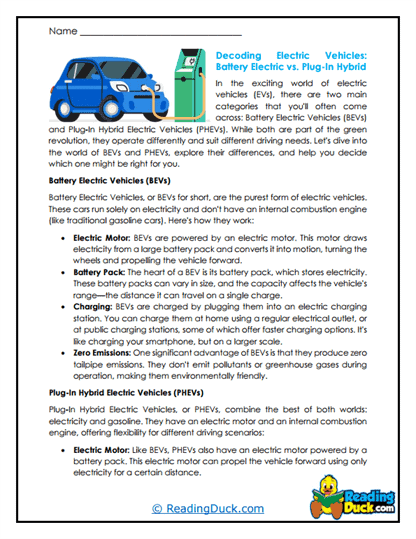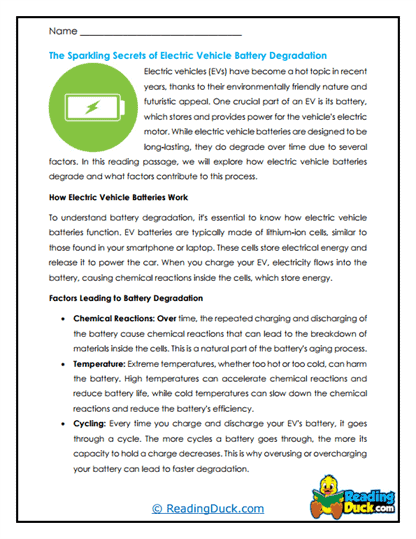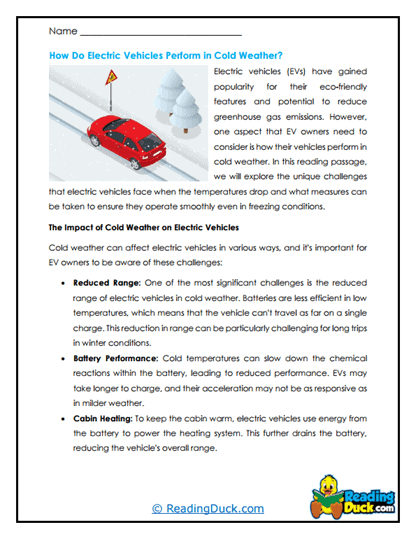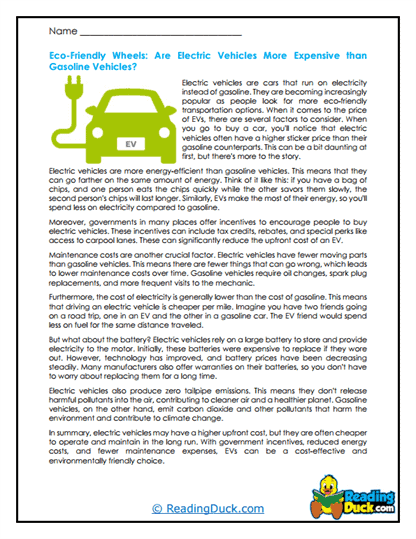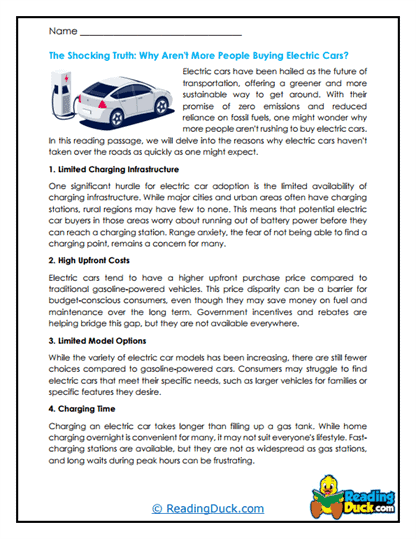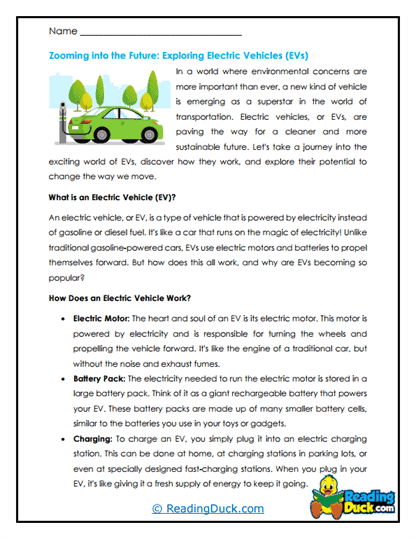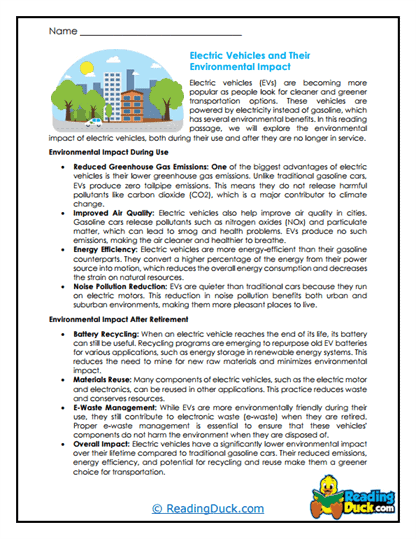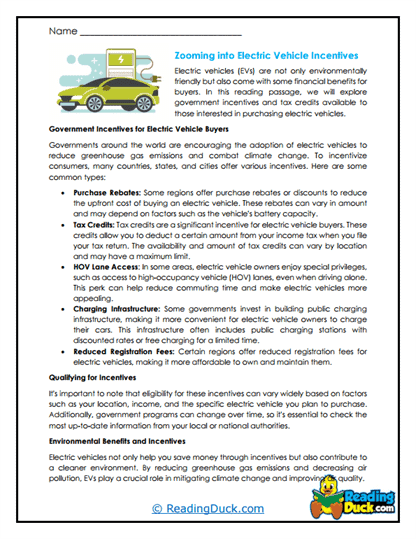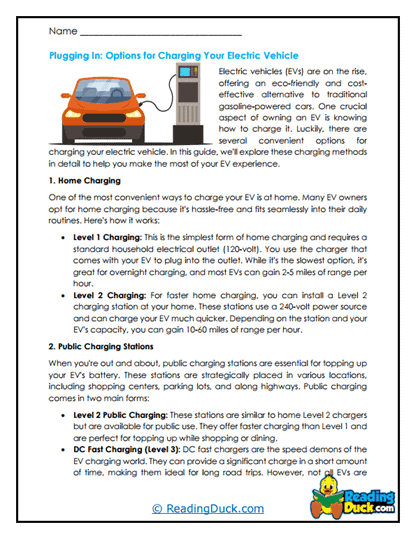Electric Cars Worksheets
About Our Electric Cars Worksheets
Our Electric Cars Worksheets are designed to introduce students to the exciting and rapidly evolving world of electric vehicles (EVs). Electric cars represent a significant shift in the automotive industry, focusing on sustainability, energy efficiency, and innovation. Through these worksheets, students will gain a solid understanding of the key concepts, technologies, and environmental impacts associated with electric vehicles.
In the Technology category, these worksheets are part of a broader collection that covers a variety of topics, including 3D Printing, Artificial Intelligence, Autonomous Vehicles, Blockchain and Cryptocurrencies, Cloud Computing, Cybersecurity, Data Analytics, Electric Cars, Quantum Computing, and The Internet. Each topic is carefully selected to reflect a wide range of technological applications, ensuring that there is something to engage every student and spark their curiosity.
This topic includes several worksheet sets, each focusing on a specific aspect of electric cars. The structure of each worksheet set is as follows:
- Multiple Choice Questions: These questions assess students' comprehension of the reading passage, helping them to identify and understand the core concepts related to electric cars.
- Short Answer Questions: Students are prompted to express their understanding in their own words, encouraging critical thinking and reinforcing their grasp of the material.
- Open-Ended Questions: These questions invite students to share their personal opinions, reflections, and predictions about electric vehicles, fostering a deeper connection to the topic and promoting thoughtful engagement.
Each worksheet comes with an answer key to assist educators in evaluating students' understanding. All of the worksheets are available as PDF files, which can be easily accessed, downloaded, and printed, making them a versatile resource for both classroom and homeschool settings.
The Future of Transportation: Understanding Electric Cars
Electric cars, also known as electric vehicles (EVs), are automobiles powered entirely or partially by electricity. Unlike traditional internal combustion engine vehicles, which rely on gasoline or diesel, electric cars use electric motors and are powered by rechargeable batteries. The shift from fossil fuels to electricity represents a significant advancement in transportation technology, with the potential to reduce greenhouse gas emissions, decrease dependency on fossil fuels, and create a more sustainable future.
Key Components of Electric Cars:
- Electric Motor: The electric motor is the heart of an electric car, converting electrical energy into mechanical energy to drive the vehicle. Unlike internal combustion engines, electric motors are more efficient, providing instant torque and smoother acceleration.
- Battery Pack: The battery pack stores the electrical energy needed to power the motor. Most modern electric cars use lithium-ion batteries due to their high energy density, long life, and reliability. The capacity of the battery pack determines the vehicle's range, which is the distance it can travel on a single charge.
- Charging System: Electric vehicles can be charged using various methods, including standard electrical outlets, dedicated home charging stations, or public charging stations. Charging times vary depending on the type of charger used, with fast chargers significantly reducing the time required to recharge the battery.
- Regenerative Braking: Regenerative braking is a technology that allows the electric motor to act as a generator during braking, converting kinetic energy back into electrical energy and storing it in the battery. This process helps extend the range of the vehicle and improves overall energy efficiency.
The Environmental Impact of Electric Cars
Electric cars have the potential to significantly reduce the environmental impact of transportation. By producing zero tailpipe emissions, EVs help reduce air pollution, which is a major contributor to respiratory diseases and environmental degradation. Additionally, the shift to electric vehicles can reduce greenhouse gas emissions, as electricity generation from renewable sources like wind, solar, and hydropower becomes more prevalent.
However, the environmental benefits of electric cars are influenced by factors such as the source of electricity used for charging and the lifecycle impact of battery production. Educating students about these aspects encourages a more nuanced understanding of the environmental implications of electric vehicles and the importance of sustainable energy practices.
The Advantages of Electric Cars
- Lower Operating Costs: Electric cars are generally cheaper to operate than traditional gasoline-powered vehicles. Electricity costs less than gasoline, and electric motors require less maintenance than internal combustion engines, which have more moving parts and require regular oil changes.
- Quieter Operation: Electric cars are much quieter than their gasoline counterparts, contributing to reduced noise pollution, especially in urban areas.
- Energy Efficiency: Electric vehicles are more energy-efficient than internal combustion engine vehicles, converting a higher percentage of the energy from the battery to power the wheels.
- Incentives and Rebates: Many governments offer incentives and rebates for purchasing electric vehicles, including tax credits, reduced registration fees, and access to carpool lanes, making EVs an attractive option for consumers.
Challenges Facing Electric Cars
While electric cars offer many benefits, there are also challenges to widespread adoption:
- Range Anxiety: One of the main concerns for potential EV buyers is "range anxiety," the fear that the vehicle's battery will run out of charge before reaching the destination. Although advancements in battery technology have extended the range of electric cars, this concern still exists, particularly in areas with limited charging infrastructure.
- Charging Infrastructure: The availability and accessibility of charging stations are critical for the adoption of electric vehicles. Expanding the charging infrastructure, especially in rural areas, is essential to support the growing number of EVs on the road.
- Battery Life and Recycling: The production and disposal of lithium-ion batteries pose environmental challenges. Developing efficient battery recycling methods and finding alternative materials for batteries are crucial for minimizing the environmental impact of electric vehicles.
Creative Uses for These Worksheets
To help students engage more deeply with the topic of electric cars, here are some creative and effective ways to incorporate these worksheets into classroom activities or homeschool lessons:
1. Real-World Case Studies
- Have students research and present case studies of cities or countries that have successfully integrated electric vehicles into their transportation systems. They can explore how these regions have addressed challenges such as charging infrastructure and public adoption.
2. Cross-Curricular Integration
- Science: Integrate the study of electric cars with lessons on renewable energy, battery technology, and environmental science. Students can explore how advancements in these areas are driving the growth of the electric vehicle market.
- Math: Use data from electric car models to teach students about energy efficiency, cost savings, and the mathematics of charging times and range calculations.
3. Debate and Discussion
- Organize a classroom debate on the pros and cons of electric vehicles compared to traditional gasoline-powered cars. Encourage students to use data and facts from their worksheets to support their arguments.
4. Design Your Own Electric Car
- Have students design their own electric car, considering factors such as battery capacity, range, design, and features. They can create drawings, models, or presentations to showcase their ideas and explain the reasoning behind their design choices.
5. Environmental Impact Project
- Assign students to calculate the environmental impact of switching from a gasoline-powered car to an electric vehicle. They can compare the carbon footprint, energy consumption, and cost over the lifetime of the vehicle.
6. Virtual Field Trips
- Take students on a virtual field trip to a car manufacturing plant that produces electric vehicles. Many companies offer virtual tours, giving students an inside look at how electric cars are made and the technology behind them.
7. Predicting the Future
- Encourage students to make predictions about the future of electric vehicles. What technological advancements do they expect? How might the market change? What will be the role of electric cars in addressing climate change?
8. Hands-On Experiment
- If possible, conduct a hands-on experiment with a simple electric motor or battery-powered car kit. This activity can help students understand the principles of how electric cars work on a smaller scale.
9. Guest Speakers
- Invite a guest speaker, such as a local EV owner, car dealership representative, or sustainability expert, to talk to students about their experiences and insights into the world of electric vehicles.
10. Creative Writing
- Ask students to write a short story or essay imagining a future where electric vehicles are the norm. How has society changed? What challenges remain? What innovations have emerged?
By using these Electric Cars Worksheets creatively, educators can help students build a comprehensive understanding of electric vehicles and their significance in shaping the future of transportation. These worksheets provide a versatile and accessible resource for exploring one of the most important areas of modern technology, equipping students with the knowledge and skills needed to navigate the transition to sustainable transportation.
